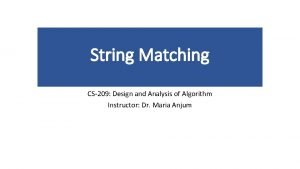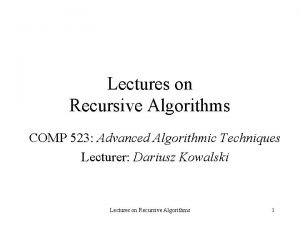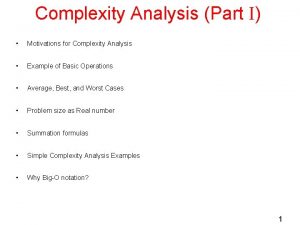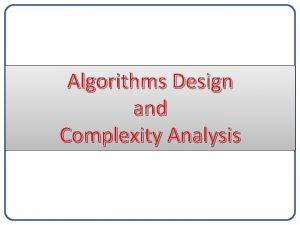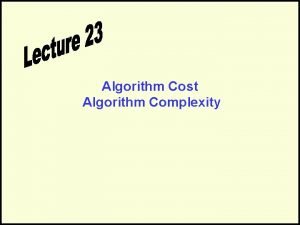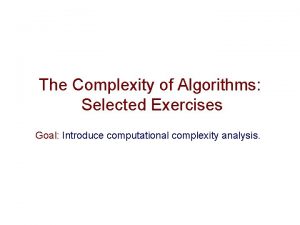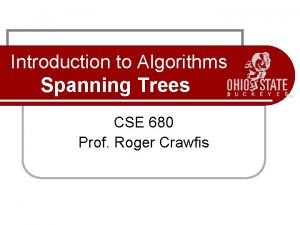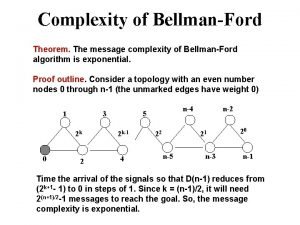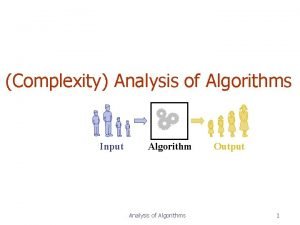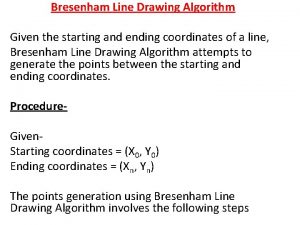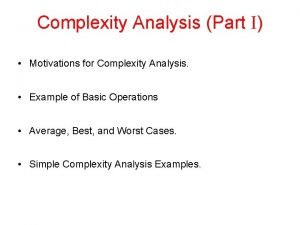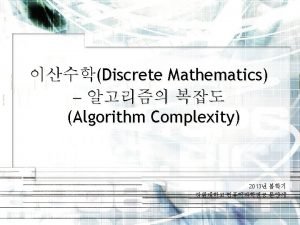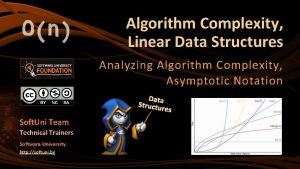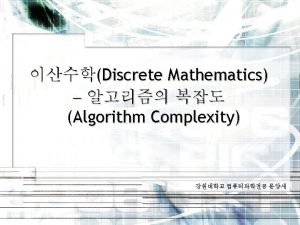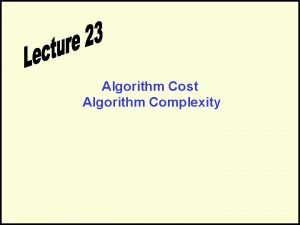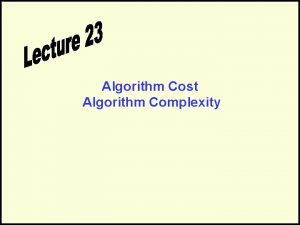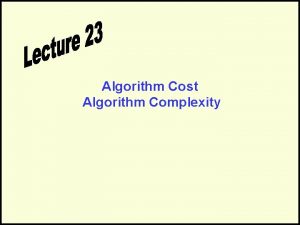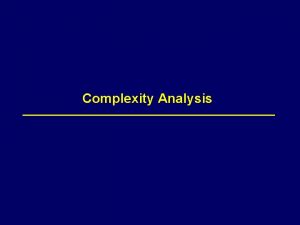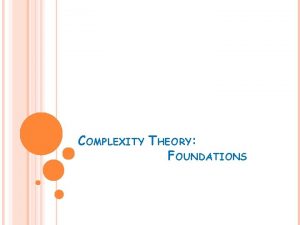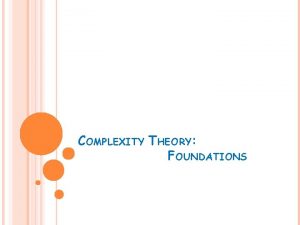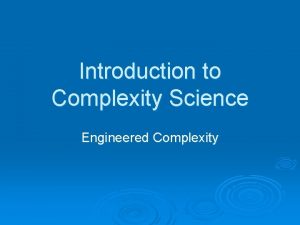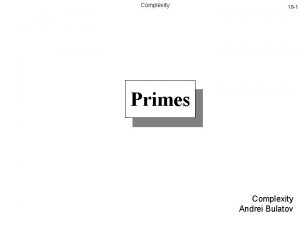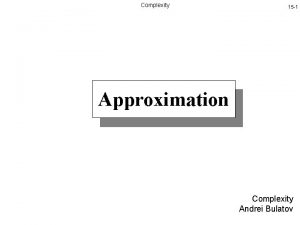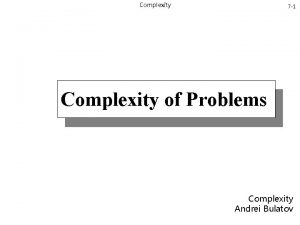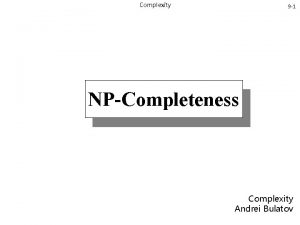Algorithm Complexity L Grewe 1 Algorithm Efficiency There



![Examples of Growth Rate Example 1. // Find largest value int largest(int array[], int Examples of Growth Rate Example 1. // Find largest value int largest(int array[], int](https://slidetodoc.com/presentation_image_h2/9077e55ecefe27a4ddbe01389ca62858/image-4.jpg)















- Slides: 19

Algorithm Complexity L. Grewe 1

Algorithm Efficiency There are often many approaches (algorithms) to solve a problem. How do we choose between them? At the heart of computer program design are two (sometimes conflicting) goals. 1. To design an algorithm that is easy to understand, code, debug. 2. To design an algorithm that makes efficient use of the computer’s resources.

How to Measure Efficiency? 1. Empirical comparison (run programs) 2. Asymptotic Algorithm Analysis Critical resources: Factors affecting running time: For most algorithms, running time depends on “size” of the input. Running time is expressed as T(n) for some function T on input size n.
![Examples of Growth Rate Example 1 Find largest value int largestint array int Examples of Growth Rate Example 1. // Find largest value int largest(int array[], int](https://slidetodoc.com/presentation_image_h2/9077e55ecefe27a4ddbe01389ca62858/image-4.jpg)
Examples of Growth Rate Example 1. // Find largest value int largest(int array[], int n) { int currlarge = 0; // Largest value seen for (int i=1; i<n; i++) // For each val if (array[currlarge] < array[i]) currlarge = i; // Remember pos return currlarge; // Return largest } As n grows, how does T(n) grow? Cost: T(n) = c 1 n + c 2 steps

Examples (cont) Example 2: Assignment statement. Constant growth Example 3: sum = 0; for (i=1; i<=n; i++) for (j=1; j<n; j++) sum++; } T(n) = c 1 n 2 + c 2

Growth Rate Graph

Best, Worst, Average Cases Not all inputs of a given size take the same time to run. Sequential search for K in an array of n integers: • Begin at first element in array and look at each element in turn until K is found Best case: Cost = 1 Worst case: Cost = n Average case: (n+1)/2 compares if K equally likely in any position

Which Analysis to Use? While average time appears to be the fairest measure…but, how to measure it? When is the worst case time important? Average time analysis requires knowledge of distributions. For example, the assumption of distribution used for average case in the last example.

Faster Computer or Algorithm? What happens when we buy a computer 10 times faster? T(n) n n’ Change 10 n 1, 000 10, 000 n’ = 10 n 20 n 500 5, 000 n’ = 10 n 5 n log n 250 1, 842 10 n < n’ < 10 n 2 n 2 70 223 n’ = 10 n 2 n 13 16 n’ = n + 3 n’/n 10 10 7. 37 3. 16 -----

When go to computer 10 times faster n: Size of input that can be processed in one hour (10, 000 steps). n’: Size of input that can be processed in one our on the new machine (100, 000 steps). Note: for 2 n, if n = 1000, then n’ would be 1003. 10

Asymptotic Analysis: Big-oh O(x) Definition: For T(n) a non-negatively valued function, T(n) is in the set O(f(n)) if there exist two positive constants c and n 0 such that T(n) <= cf(n) for all n > n 0. Usage: The algorithm is in O(n 2) in [best, average, worst] case. Meaning: For all data sets big enough (i. e. , n>n 0), the algorithm always executes in less than cf(n) steps in [best, average, worst] case. pick one of [best, average, worst]. Big-oh notation applies to some set of bounds.

Big-oh Notation O() is an upper bound. Example: If T(n) = 3 n 2 then T(n) is in O(n 2). Use the “tightest bounds”: While T(n) = 3 n 2 is in O(n 3), we prefer O(n 2). It provides more information in this example to say O(n 2) than O(n 3).

Big-Oh Examples Example 1: Finding value X in an array (average cost). T(n) = csn/2. For all values of n > 1, csn/2 <= csn. Therefore, by the definition, T(n) is in O(n) for n 0 = 1 and c = cs.

A Common Misunderstanding “The best case for my algorithm is n=1 because that is the fastest. ” WRONG! Big-oh refers to a growth rate as n grows to . Best case is defined as which input of size n is cheapest among all inputs of size n.

Big-Omega () -- Lower Bound Definition: For T(n) a non-negatively valued function, T(n) is in the set (g(n)) if there exist two positive constants c and n 0 such that T(n) >= cg(n) for all n > n 0. Meaning: For all data sets big enough (i. e. , n > n 0), the algorithm always executes in more than cg(n) steps. Lower bound.

Big-Omega Example T(n) = c 1 n 2 + c 2 n >= c 1 n 2 for all n > 1. T(n) >= cn 2 for c = c 1 and n 0 = 1. Therefore, T(n) is in (n 2) by the definition. Always take the greatest lower bound.

Theta Notation () When big-Oh and meet, we indicate this by using (big-Theta) notation. Definition: An algorithm is said to be (h(n)) if it is in O(h(n)) and it is in (h(n)). NOTE: For polynomial equations on T(n), we always have .

A Common Misunderstanding Confusing worst case with upper bound. Upper bound refers to a growth rate. Worst case refers to the worst input from among the choices for possible inputs of a given size.

Space/Time Tradeoff Principle One can often reduce time if one is willing to sacrifice space, or vice versa. • • Encoding or packing information Boolean flags Table lookup Factorials Disk-based Space/Time Tradeoff Principle: The smaller you make the disk storage requirements, the faster your program will run.
 Virtuozzo docker
Virtuozzo docker Time space complexity of algorithm
Time space complexity of algorithm Productive inefficiency and allocative inefficiency
Productive inefficiency and allocative inefficiency Allocative efficiency vs productive efficiency
Allocative efficiency vs productive efficiency Productive inefficiency and allocative inefficiency
Productive inefficiency and allocative inefficiency V5-7gzofadq -site:youtube.com
V5-7gzofadq -site:youtube.com 5,7 height
5,7 height Iterative deepening search
Iterative deepening search Binary search average case time complexity
Binary search average case time complexity How to calculate time complexity in data structure
How to calculate time complexity in data structure Depth first search algorithm complexity
Depth first search algorithm complexity Time complexity of algorithms
Time complexity of algorithms Algorithm complexity
Algorithm complexity Time complexity exercises
Time complexity exercises Kruskal time complexity
Kruskal time complexity Bellman ford complexity
Bellman ford complexity Algorithm complexity analysis
Algorithm complexity analysis Steps of bresenham line drawing algorithm
Steps of bresenham line drawing algorithm Log n
Log n Quick sort worst complexity
Quick sort worst complexity





